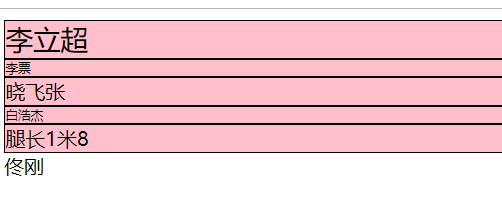一,常用的基本选择器
1.最基本的了
<!DOCTYPE html> <html lang="en"> <head> <meta charset="UTF-8"> <title>基本选择器</title> <style type="text/css"> /*通配符选择器*/ * { margin: 0; padding: 0; border: none; } /*元素选择器*/ body { background: #eee; } /*类选择器*/ .list { list-style: square; } /*ID选择器*/ #list { width: 500px; margin: 0 auto; } /*后代选择器*/ .list li { margin-top: 10px; background: #abcdef; } /*选择器分组*/ #list,.second{background: pink;} </style> </head> <body> <ul id="list" class="list"> <li class="first">1</li> <li class="second">2</li> <li>3</li> <li>4</li> </ul> </body> </html>
2,子元素和兄弟选择器
<!DOCTYPE html> <html lang="en"> <head> <meta charset="UTF-8"> <title>子元素选择器</title> <!--我们也可以称它为直接后代选择器--> <style type="text/css"> #wrap>.inner { color: pink; border: 1px solid; } /* 这被称为一个相邻兄弟选择器. 它只会匹配紧跟着的兄弟元素 紧跟!!!! */ #wrap>#first+.inner { color: blue; border: 1px solid; } /* 在使用 ~ 连接两个元素时,它会匹配第二个元素, 条件是 它必须跟(不一定是紧跟)在第一个元素之后, 且他们都有一个共同的父元素 */ #wrap2 #second~div { border: 1px solid #f5f5f5; /*color: pink;*/ } </style> </head> <body> <div id="wrap"> <div class="inner"> wrap下一层 <div class="inner"> 最里层</div> <!-- 孙子层无效果 --> </div> <div class="inner">wrap下一层</div> <div class="inner">inner</div> <div id="first">first</div> <div class="inner">inner <!-- 此行生效 --> </div> <div id="wrap2"> <div id="second">first</div> <p></p> <div class="inner">inner <div>inner2</div> </div><!-- 生效 --> <div class="inner">inner</div><!-- 生效 --> <div class="inner">inner</div><!-- 生效 --> <div class="inner">inner</div><!-- 生效 --> </div> </div> </body> </html>
二,元素选择器
<meta charset="UTF-8"> <title>存在和值属性选择器</title> <style type="text/css"> /* [attr]:该选择器选择包含 attr 属性的所有元素,不论 attr 的值为何。 */ [name] { border: 1px solid; } /* [attr=val]:该选择器仅选择 attr 属性被赋值为 val 的所有元素。 */ [name="atguigu_llc"] { font-size: 22px; } /* [attr~=val]:该选择器仅选择 attr 属性的值(以空格间隔出多个值)中有包含 val 值的所有元素, 比如位于被空格分隔的多个类(class)中的一个类。 */ [name~="atguigu"] { font-size: 10px; } /* [attr|=val] : 选择attr属性的值以val(包括val)或val-开头的元素 [attr^=val] : 选择attr属性的值以val开头(包括val)的元素。 [attr$=val] : 选择attr属性的值以val结尾(包括val)的元素。 [attr*=val] : 选择attr属性的值中包含字符串val的元素。 */ [name*="atguigu"] { background: pink; } </style> </head> <body> <div name="atguigu_llc">李立超</div> <div name="atguigu-llc atguigu">李票</div> <div name="atguigu-xfz">晓飞张</div> <div name="atguigu-bhj atguigu">白浩杰</div> <div name="atguigu_sym">腿长1米8</div> <div>佟刚</div> </body> </html>

三,伪类与伪元素选择器
1.链接伪类和动态伪类
<!DOCTYPE html> <html> <head> <meta charset="UTF-8"> <title></title> <!--:link:表示作为超链接,并指向一个未访问的地址的所有锚--> <style type="text/css"> a { text-decoration: none; } /* 锚点伪类 点击后,已经点击过的 */ a:visited { color: rgb(201, 131, 110); } /* 锚点伪类 点击后鼠标未松开 */ a:link { color: deeppink; } /* 锚点伪类 不是a标签,无效果 */ #test:link { background: pink; } /* 动态伪类 鼠标移上去时*/ a:hover { color: blue; } /* 动态伪类 鼠标点击时未松开*/ a:active { color: aqua; } /* 动态伪类 有效果时*/ #test:link { background: pink; } </style> </head> <body> <a href="#">点我点我点我</a> <div id="test">我是div啦</div> </body> </html>
2.表单相关伪类
<!DOCTYPE HTML> <html> <head> <meta http-equiv="Content-Type" content="text/html; charset=utf-8"> <title>无标题文档</title> <style> input { width: 100px; height: 30px; color: #000; } /* 可用和不可用 */ input:enabled { color: red; } input:disabled { color: blue; } input:checked { width: 100px; height: 100px; } /* 获取焦点 */ input:focus { background: pink; } div:focus { background: pink; } </style> </head> <body> <input type="text" value="晓飞张" /> <input type="text" value="晓飞张" disabled="disabled" /> <input type="checkbox" /> <input type="text" value="" /> <div style="width: 200px;height: 200px;background: deeppink;" contenteditable="true"></div> </body> </html>
3.结构性伪类元素
/* :first-of-type p:first-of-type 选择每个p元素是其父级的第一个p元素 :last-of-type p:last-of-type 选择每个p元素是其父级的最后一个p元素 :only-of-type p:only-of-type 选择每个p元素是其父级的唯一p元素 :nth-of-type(n) p:nth-of-type(2) 选择每个p元素是其父级的第二个p元素 ..... */